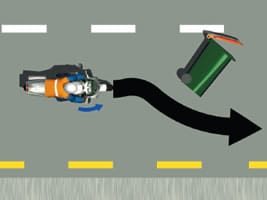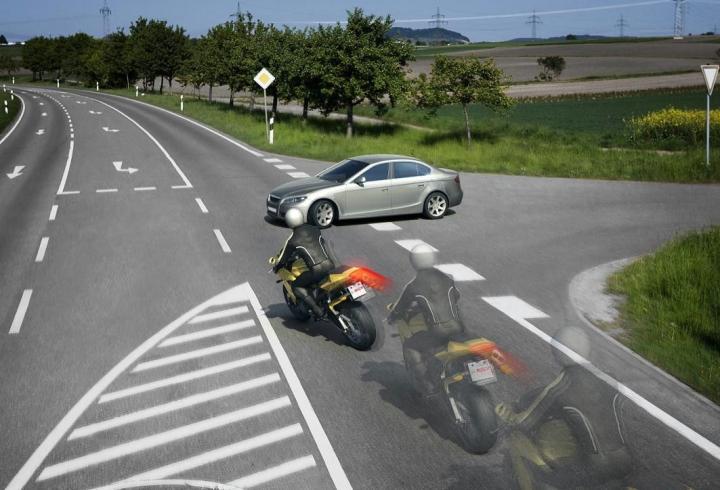Motorcycle Braking
Braking, as with any other riding technique, is a learned ability. It is not a natural skill, but something that is studied and put into practice. Before you can be certain that you will do the right things in a crisis, you must learn the proper braking techniques first, enough to make them an instinctual response.
Based on broad research, about 33% of all riders do literally nothing in an adverse circumstance. They don’t even apply the brakes! This is as a result of panic that overwhelms the rider’s calm and calculated response to the crisis. If, however, your emergency braking techniques are so well learnt that they are intuitive, you will do it right, regardless of what the circumstances are. 
Then again, this obliges you to do a ton of emergency braking practice, as hopefully, you will not be called upon to carry out emergency braking in every typical riding situation.
In this article, we will discuss some very important types of motorcycle braking techniques that you should become expert with.
As an experienced motorcycle instructor I am continually surprised at how many motorcyclists, some who are riding very powerful machines, do not have the knowledge and skills to make good decisions at the time when emergency braking is required.
- Will I go over the handlebars?
- Will the front wheel lock?
- Should I use the front Brake?
- How far can I lean over on the brakes?
- How hard can I brake?
Hard Braking on the Front Wheel
The front brake is proven to be the best and most effective of the two brakes, giving up to 80%-90% of the motorcycle’s stopping power in emergency stops, contingent on surface conditions. For this reason a large percentage of weight of the motorcycle and rider needs to transfer forward onto the front wheel and suspension when the brakes are applied.
The weight transfer that happens under braking on a motorcycle compresses the front forks and then pushes down on the front tyre, enlarging the contact patch and thereby increasing the grip.
Training Options
Training to perform correct braking procedure is important. Remember that you in an emergency and it doesn’t matter what kind of emergency you fall back on your training. This training needs to instill the correct procedure into muscle memory because in an emergency there is no opportunity to consider options and then apply the correct procedure. It is recommend to consider learning advanced skills at a training organisation. Even motorcycle racers learn and hone their skills by using a coach. Very few motorcyclists are really in a position to say, ” I know it all”
Hard Braking on the Rear Wheel
With most of the weight transferring to the front wheel under braking, the back wheel has a tendency to become light under braking. Because of this the rear wheel can lock up quite readily if over-applied. If the rear wheel does lock it will cause the motorcycle to skid. If this happens it is vital for the rider to maintain “eyes-up” and keep the feet on the footpegs.
If the motorcycle is still travelling in a straight line, release the pressure on the rear brake lever immediately to stop the skid. If the back of the motorcycle has started to slide sideways, steer into the skid to straighten the bike and then release the pressure on the rear brake lever.
Smooth and safe braking techniques are best learned under controlled conditions instead of when it becomes a “life or death” reality in traffic!
Your Vicroads accredited motorcycle school such as Ride-Tek MTA will run courses specifically designed to help you develop safe braking techniques. All specialty skills courses are fun and are designed to help you to develop good skills in a safe environment, enabling you to become a much safer road rider.

Braking Technique
A rider should spend time developing and practicing sound braking technique. This is the most valuable skill to you as a road rider.
If you are approaching a red light intersection as you roll off the throttle and start to slow down you should also check your mirrors to ensure the following traffic are at a safe distance. Apply gentle “set-up” pressure to both brakes to start the weight transfer happening and then progressively “squeeze” both brake levers (front and rear) but try to apply more pressure to the front brake lever rather than the rear.
This progressively loads up the weight onto the front suspension, increasing the contact patch of the front tyre, and will bring the motorcycle to a safe stop.
The rear brake application slows the rear wheel and helps keep the back of the motorcycle in line, as well as helping to stop.
The rider should also progressively change down through the gears so that the engine provides some compression braking, and ideally when the motorcycle stops at the intersection, the rider should already be in 1st gear, ready to move off.
Very importantly the rider should always remember to check mirrors when slowing down and again as soon as the motorcycle stops.
In a “normal stopping” situation ideally the front brake should be supplying about 70% of the braking effort and the rear brake about 30%.
If you need to stop in an emergency the “set-up” and “squeeze” technique is still applicable, however in this situation the front brake should be supplying about 90% of the braking effort and the rear brake only about 10%.
Ride-Tek is conveniently located at the Sandown Racetrack, at Gate 16 591-659 Princes Hwy, Springvale or 74 Boundary Road, Sunshine West, Victoria
Very easy to go to no matter where you are located in Melbourne or other areas of Victoria.


